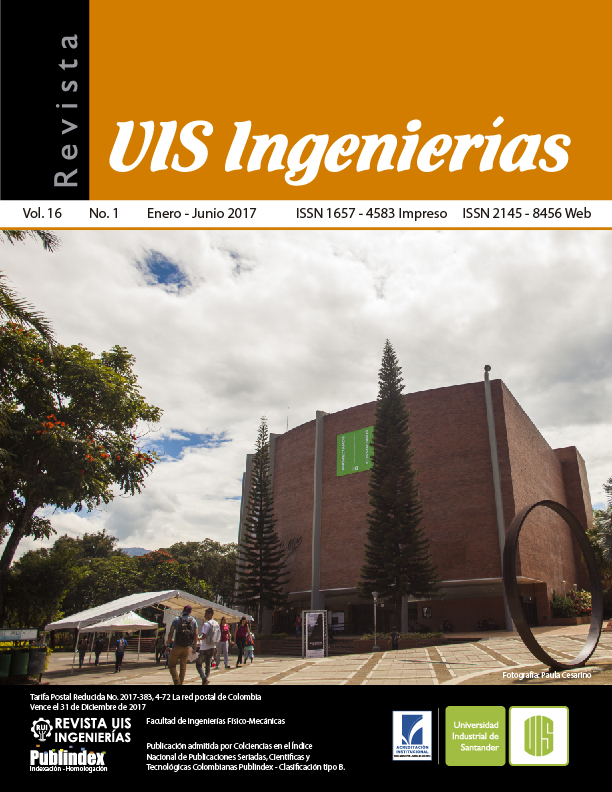Published 2016-12-30
Keywords
- Microrredes en AC,
- inversores,
- tipos de inversores,
- principales topologías
How to Cite
Copyright (c) 2016 Revista UIS Ingenierías

This work is licensed under a Creative Commons Attribution-NoDerivatives 4.0 International License.
Abstract
Inverters are the key actuator in the control of AC microgrids, since they manage the power flows of both the generators and energy storage devices. In general, there are three types of inverters depending on the control strategy: grid feeding inverters, grid forming inverters and grid supporting inverters. Those inverters can be implemented with different hardware topologies, each one of them with advantages and disadvantages. This paper presents a sinthesis of the widely used inverter topologies used in AC microgrids. Moreover, this paper also describes the inverters control architectures and the main strategies
Downloads
References
- REN21, “Renewables 2016 Global Status Report,” 2016.
- M. S. Mahmoud and F. M. AL-Sunni, Control and Optimization of Distributed Generation Systems. Springer, 2010.
- N. Hatziargyriou, Microgrids Architectures and Control. John Wiley & Sons Ltd, 2014.
- S. M. Sharkh, M. A. Abusara, G. I. Orfanoudakis, and B. Hussain, Power Electronic Converters for Microgrids. JohnWiley & Sons Singapore Pte. Ltd., 2014.
- O. Palizban, K. Kauhaniemi, and J. M. Guerrero, “Microgrids in active network management - Part I: Hierarchical control, energy storage, virtual power plants, and market participation,” Renew. Sustain. Energy Rev., vol. 36, pp. 428–439, Jan. 2014.
- Z. Zeng, H. Yang, R. Zhao, and C. Cheng, “Topologies and control strategies of multi-functional grid-connected inverters for power quality enhancement: A comprehensive review,” Renew. Sustain. Energy Rev., vol. 24, pp. 223–270, 2013.
- J. M. Guerrero, P. C. Loh, T. L. Lee, and M. Chandorkar, “Advanced control architectures for intelligent microgrids; Part II: Power quality, energy storage, and AC/DC microgrids,” IEEE Trans. Ind. Electron., vol. 60, no. 4, pp. 1263–1270, 2013.
- J. Rocabert, A. Luna, F. Blaabjerg, and I. Paper, “Control of Power Converters in AC Microgrids,” IEEE Trans. Power Electron., vol. 27, no. 11, pp. 4734–4749, 2012.
- J. M. Guerrero, M. Chandorkar, T. Lee, and P. C. Loh, “Advanced Control Architectures for Intelligent Microgrids; Part I: Decentralized and Hierarchical Control,” Ind. Electron. IEEE Trans., vol. 60, no. 4, pp. 1254–1262, 2013.
- J. Bao, W. Bao, and J. Gong, “A PWM Multilevel Current-Source Inverter Used for Grid-Connected Wind Energy Conversion System,” Energy Procedia, vol. 16, no. 0, pp. 461–466, 2012.
- S. H. Lee, S. G. Song, S. J. Park, C. J. Moon, and M. H. Lee, “Grid-connected photovoltaic system using current-source inverter,” Sol. Energy, vol. 82, no. 5, pp. 411–419, 2008.
- J. W. Kolar, F. Schafmeister, S. D. Round, and H. Ertl, “Novel three-Phase AC-AC sparse matrix converters,” in 17th Annual IEEE Applied Power Electronics Conference and Exposition, 2002. APEC 2002, 2002, vol. 2, pp. 777–791.
- S. M. Barakati, M. Kazerani, S. Member, and X. Chen, “A New Wind Turbine Generation System Based on Matrix Converter,” in Power Engineering Society General Meeting, 2005. IEEE, 2005, pp. 2083 – 2089.
- X. She, A. Q. Huang, S. Lukic, and M. E. Baran, “On integration of solid-state transformer with zonal DC microgrid,” IEEE Trans. Smart Grid, vol. 3, no. 2, pp. 975–985, 2012.
- B. Starfield, “State of the Art in Research on Microgrids: A Review,” IEEE Access, vol. 3, pp. 890 – 925, 2015.
- A. Chauhan and R. P. Saini, “A review on Integrated Renewable Energy System based power generation for stand-alone applications: Configurations, storage options, sizing methodologies and control,” Renew. Sustain. Energy Rev., vol. 38, pp. 99–120, Oct. 2014.
- ABB, “ABB string inverters.” pp. 1–4, 2014.
- SMA, “Sunny Boy 2500TL / 3000TL Single Tracker,” 2014. [Online]. Available: http://files.sma.de/dl/17201/SB3000TLST-21-DEN140417W.pdf.
- M. R. Miveh, M. F. Rahmat, A. A. Ghadimi, and M. W. Mustafa, “Control techniques for three-phase four-leg voltage source inverters in autonomous microgrids: A review,” Renew. Sustain. Energy Rev., vol. 54, pp. 1592–1610, Feb. 2016.
- M. Hamzeh, A. Ghazanfari, H. Mokhtari, and H. Karimi, “Integrating hybrid power source into an Islanded MV microgrid using CHB multilevel inverter under unbalanced and nonlinear load conditions,” IEEE Trans. Energy Convers., vol. 28, no. 3, pp. 643–651, 2013.
- M. Barghi Latran and A. Teke, “Investigation of multilevel multifunctional grid connected inverter topologies and control strategies used in photovoltaic systems,” Renew. Sustain. Energy Rev., vol. 42, pp. 361–376, 2015.
- L. Wang, D. Zhang, Y. Wang, B. Wu, and H. S. Athab, “Power and voltage balance control of a novel three-phase solid-state transformer using multilevel cascaded H-bridge inverters for microgrid applications,” IEEE Trans. Power Electron., vol. 31, no. 4, pp. 3289–3301, 2016.
- F. Wang, J. L. Duarte, and M. A. M. Hendrix, “Grid-interfacing converter systems with enhanced voltage quality for microgrid applicationconcept and implementation,” IEEE Trans. Power Electron., vol. 26, no. 12, pp. 3501–3513, 2011.
- P. P. Dash and M. Kazerani, “Dynamic Modeling and Performance Analysis of a Grid-Connected Current-Source Inverter-Based Photovoltaic System,” IEEE Trans. Sustain. Energy, vol. 2, no. 4, pp. 443–450, 2011
